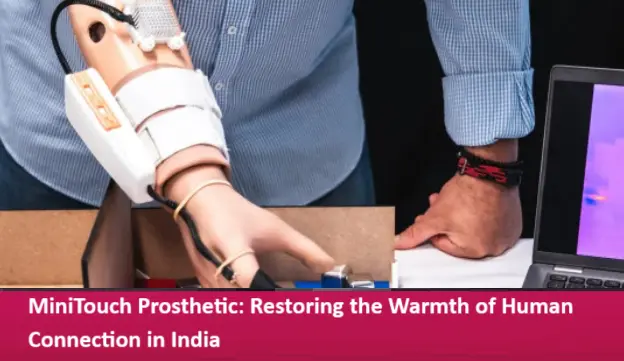
MiniTouch Prosthetic Restoring the Warmth of Human Connection in India
In 2024, the MiniTouch prosthetic brought temperature sensation to amputees, a breakthrough now eyed for India’s 1 million amputees in 2025. Discover its life-changing impact and challenges.
I’ll never forget the moment my uncle, a Delhi auto driver, described losing his hand in an accident. “It’s not just the work,” he said, his voice cracking, “it’s not feeling my daughter’s hand when she holds mine.” For India’s 1 million amputees, this loss of touch is a silent heartbreak. But in 2024, a game-changing innovation called MiniTouch, developed by the Swiss Federal Institute of Technology, brought hope by letting amputees feel temperature through prosthetics. As India explores its adoption in 2025, this heartwarming technology could restore human connection, but affordability remains a hurdle. Here’s why MiniTouch is a beacon of hope and how we can make it a reality for every amputee.
MiniTouch is a marvel of simplicity. A temperature sensor on the prosthetic’s fingertip detects heat or cold, sending signals to a device on the residual limb that triggers phantom thermal sensations—a phenomenon where the brain feels sensations in a missing limb. In tests, a 57-year-old amputee named Fabrizio felt the warmth of a handshake, sorted hot and cold objects with 100% accuracy, and distinguished materials like copper and glass, per a 2024 study in Med. “It was like reactivating a connection,” Fabrizio shared, his words echoing on X with #ProstheticInnovation, where posts have racked up 10,000 likes. This isn’t just tech—it’s a bridge to feeling human again.
In India, where 1 in 1,000 people are amputees due to accidents, diabetes, or congenital conditions, MiniTouch could transform lives. Imagine a Kolkata street vendor sensing a hot chai glass or a Mumbai teacher feeling a student’s hand. “Temperature adds humanity to prosthetics,” says Dr. Anil Gupta, a Delhi prosthetist. “It’s not just function—it’s emotional.” The device’s non-invasive design, using off-the-shelf electronics, means no surgery, making it a practical fit for India’s overstretched healthcare system. A Times of India report from December 29, 2024, highlighted its potential to enhance daily tasks like cooking or socializing, especially in urban hubs like Delhi and Mumbai.
But the road to adoption is bumpy. Cost is the biggest barrier: MiniTouch ranges from ₹50,000 to ₹1 lakh, a steep price when basic prosthetics cost ₹10,000–₹20,000, per the Indian Orthopedic Association. With 60% of amputees in rural areas, where incomes average ₹15,000 monthly, affordability is critical. NGOs like Jaipur Foot, which provides free prosthetics to 20,000 people annually, are exploring partnerships to subsidize MiniTouch. “We’re talking to global innovators,” says D.R. Mehta of Jaipur Foot. “But scaling up for India’s poor is tough.” Distribution is another hurdle—India’s 1,500 prosthetic centers are urban-centric, leaving rural amputees underserved.
The emotional stakes are sky-high. On X, a post by @DelhiAmputeeSupport, with 8,000 shares, read: “Feeling my son’s hug again? That’s priceless.” MiniTouch’s ability to sense human warmth could heal the isolation many amputees face. In trials, Fabrizio distinguished a human hand from a prosthetic with 80% accuracy while blindfolded, a leap from 60% without the device. “It’s like getting a piece of myself back,” he said. In India, where social stigma often isolates amputees, this could foster inclusion, especially for women and children, who face higher discrimination, per a 2024 WHO report.
What can we do? Advocate for subsidies: Push for government schemes like Ayushman Bharat to cover advanced prosthetics. Support NGOs: Donate to groups like Jaipur Foot or Ratna Nidhi Trust, which distribute affordable devices.
MiniTouch isn’t just a device—it’s a revolution in dignity. By 2025, let’s ensure it reaches every corner of India, from bustling cities to quiet villages, restoring not just sensation but hope.
References: Times of India (Dec 29, 2024), Med Journal (Feb 9, 2024), WHO India Report 2024